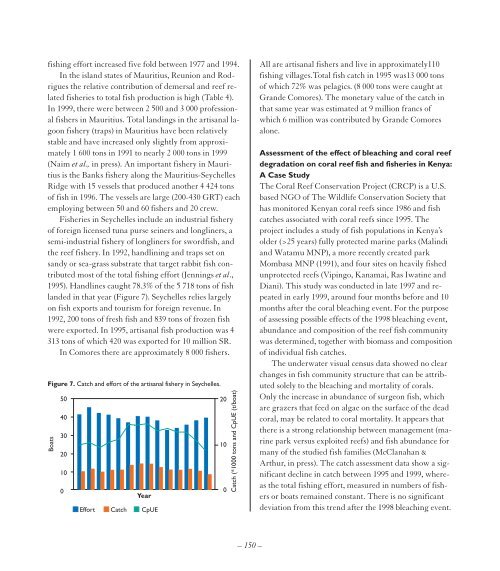Create successful ePaper yourself
Turn your PDF publications into a flip-book with our unique Google optimized e-Paper software.
fishing effort increased five fold between 1977 and 1994.<br />
In the island states of Mauritius, Reunion and Rodrigues<br />
the relative contribution of demersal and reef related<br />
fisheries to total fish production is high (Table 4).<br />
In 1999, there were between 2 500 and 3 000 professional<br />
fishers in Mauritius. Total landings in the artisanal lagoon<br />
fishery (traps) in Mauritius have been relatively<br />
stable and have increased only slightly from approximately<br />
1 600 tons in 1991 to nearly 2 000 tons in 1999<br />
(Naim et al., in press). An important fishery in Mauritius<br />
is the Banks fishery along the Mauritius-Seychelles<br />
Ridge with 15 vessels that produced another 4 424 tons<br />
of fish in 1996. The vessels are large (200-430 GRT) each<br />
employing between 50 and 60 fishers and 20 crew.<br />
Fisheries in Seychelles include an industrial fishery<br />
of foreign licensed tuna purse seiners and longliners, a<br />
semi-industrial fishery of longliners for swordfish, and<br />
the reef fishery. In 1992, handlining and traps set on<br />
sandy or sea-grass substrate that target rabbit fish contributed<br />
most of the total fishing effort (Jennings et al.,<br />
1995). Handlines caught 78.3% of the 5 718 tons of fish<br />
landed in that year (Figure 7). Seychelles relies largely<br />
on fish exports and tourism for foreign revenue. In<br />
1992, 200 tons of fresh fish and 839 tons of frozen fish<br />
were exported. In 1995, artisanal fish production was 4<br />
313 tons of which 420 was exported for 10 million SR.<br />
In Comores there are approximately 8 000 fishers.<br />
Figure 7. Catch and effort of the artisanal fishery in Seychelles.<br />
Boats<br />
50<br />
40<br />
30<br />
20<br />
10<br />
0<br />
Year<br />
Effort Catch CpUE<br />
20<br />
10<br />
0<br />
Catch (*1000 tons and CpUE (t/boat)<br />
All are artisanal fishers and live in approximately110<br />
fishing villages.Total fish catch in 1995 was13 000 tons<br />
of which 72% was pelagics. (8 000 tons were caught at<br />
Grande Comores). The monetary value of the catch in<br />
that same year was estimated at 9 million francs of<br />
which 6 million was contributed by Grande Comores<br />
alone.<br />
Assessment of the effect of bleaching and coral reef<br />
degradation on coral reef fish and fisheries in Kenya:<br />
A Case Study<br />
The Coral Reef Conservation Project (CRCP) is a U.S.<br />
based NGO of The Wildlife Conservation Society that<br />
has monitored Kenyan coral reefs since 1986 and fish<br />
catches associated with coral reefs since 1995. The<br />
project includes a study of fish populations in Kenya’s<br />
older (>25 years) fully protected marine parks (Malindi<br />
and Watamu MNP), a more recently created park<br />
Mombasa MNP (1991), and four sites on heavily fished<br />
unprotected reefs (Vipingo, Kanamai, Ras Iwatine and<br />
Diani). This study was conducted in late 1997 and repeated<br />
in early 1999, around four months before and 10<br />
months after the coral bleaching event. For the purpose<br />
of assessing possible effects of the 1998 bleaching event,<br />
abundance and composition of the reef fish community<br />
was determined, together with biomass and composition<br />
of individual fish catches.<br />
The underwater visual census data showed no clear<br />
changes in fish community structure that can be attributed<br />
solely to the bleaching and mortality of corals.<br />
Only the increase in abundance of surgeon fish, which<br />
are grazers that feed on algae on the surface of the dead<br />
coral, may be related to coral mortality. It appears that<br />
there is a strong relationship between management (marine<br />
park versus exploited reefs) and fish abundance for<br />
many of the studied fish families (McClanahan &<br />
Arthur, in press). The catch assessment data show a significant<br />
decline in catch between 1995 and 1999, whereas<br />
the total fishing effort, measured in numbers of fishers<br />
or boats remained constant. There is no significant<br />
deviation from this trend after the 1998 bleaching event.<br />
– 150 –


















